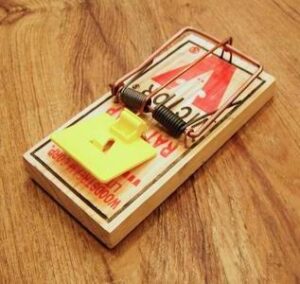House Mice: Not Welcome Visitors
By Pat Dickey, Fairfax County Master Gardener
When nights become cooler and small animals are looking for a warmer place to spend the winter, many homeowners are surprised to find mice in places where they least expect them.
 House mice, Mus musculus, are a major pest nuisance and are somewhat difficult to control and catch. They seem to gnaw on everything — wood, metal, glass, plastic and stone — to sharpen their large front teeth. They can survive with little or no water. They can enter your home through any opening that is ¼ inch in diameter. House mice weigh 1/2 ounce and are light brownish to gray. Adult mice are 5 to 7 inches long including their tails. A female can have as many as 5 to 10 litters of five to seven young. Their life span is 9 to 12 months.
House mice, Mus musculus, are a major pest nuisance and are somewhat difficult to control and catch. They seem to gnaw on everything — wood, metal, glass, plastic and stone — to sharpen their large front teeth. They can survive with little or no water. They can enter your home through any opening that is ¼ inch in diameter. House mice weigh 1/2 ounce and are light brownish to gray. Adult mice are 5 to 7 inches long including their tails. A female can have as many as 5 to 10 litters of five to seven young. Their life span is 9 to 12 months.
These tiny animals can nest within appliances, wall and floor voids, false ceilings, and behind counters. They are excellent climbers and can run up any vertical surface, including cinder blocks, metal pipes, and cables. They can also jump a foot from the floor to a flat surface.
Some preventive measures will work best to keep mice away from your house. It is important to limit their access to nesting sites and food and water supplies. House mice can contaminate food meant for humans, pets, and other animals. They can bring salmonella into your home. They sample many different foods but prefer cereal grains.
Store food in glass, metal, or thick plastic containers with tight-fitting lids. Clean up all food spills. Keep all trash receptacles covered and empty them often. Trim trees, bushes, grass, vines, and any other plants 12 to 18 inches away from your house. Keep wood piles away from the house. Eliminate all gaps and openings larger than 1/4 inch. Stainless steel wool makes a good temporary plug for holes. Do not use gnawable materials to plug the holes, such as plastic screening, rubber, vinyl, and insulating foam. Seal cracks in building foundations and around openings for water pipes, vents, and utility cables. Doors and windows should also fit tightly.

Snap trap
If there are a small number of house mice, snap traps are the best method for catching them. Add a small bait of peanut butter or bits of meat to the trigger for better results. Snap traps should be set with the trigger next to the wall. Several of them can also be placed parallel to the wall with the triggers to the outside. Be very careful with your fingers when setting the triggers. There are also newer plastic single-kill mousetraps that are easier to set and clean. Glue boards are available, but the mice will become attached to the board and will not be killed. Bait boxes should not be set up by homeowners because of the heightened risk of improper placement and exposure to people, pets and wildlife. If you have a serious contamination of mice, it is best to hire a professional pest exterminator.
Resources
Wildlife Damage Control in Virginia, Controlling Rodents in Homes, Virginia Cooperative Extension Service, Pub. 420-023
House Mouse, University of California IPM Program, Pest Notes Pub. 7483
… updated 2022